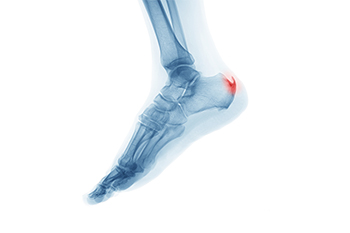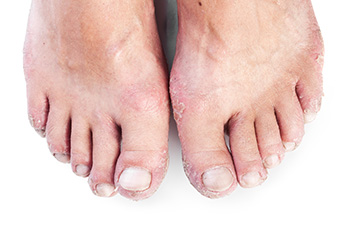February 2023
Where Are Corns Located?

Corns are a condition of the feet that is primarily defined by hard layers of skin that develop in response to friction. Corns, importantly, are distinct from calluses. Many patients and novices to the field of podiatry often wonder where, exactly, corns can develop on the feet. The answer is slightly complicated. Corns are most commonly located on the soles, or bottoms, of the feet. However, they can also be found elsewhere on the feet. For example, corns can also be found on bony parts of the foot. This is to say that corns can be located on the toes, especially around the joints. You might also be most susceptible to developing corns wherever the skin is particularly thin. If you are someone that is concerned about developing corns on your feet, it is suggested that you contact a podiatrist today for more information. Schedule an appointment today.
If you have any concerns regarding your feet and ankles, contact Dr. Steven Schwartz of Pennsylvania. Our doctor will treat your foot and ankle needs.
Corns: What Are They? and How Do You Get Rid of Them?
Corns can be described as areas of the skin that have thickened to the point of becoming painful or irritating. They are often layers and layers of the skin that have become dry and rough, and are normally smaller than calluses.
Ways to Prevent Corns
There are many ways to get rid of painful corns such as wearing:
- Well-fitting socks
- Comfortable shoes that are not tight around your foot
- Shoes that offer support
Treating Corns
Treatment of corns involves removing the dead skin that has built up in the specific area of the foot. Consult with Our doctor to determine the best treatment option for your case of corns.
If you have any questions please feel free to contact our offices located in Chambersburg, and Mcconnellsburg, PA . We offer the newest diagnostic and treatment technologies for all your foot and ankle needs.
Stretches May Provide Relief From Heel Spurs

Heel spurs are often uncomfortable, and patients may benefit from performing certain types of stretches and exercises. These may help to lengthen the plantar fascia, which can reduce stress on the heel. Calf stretches can be effective in finding relief from heel spurs. This is done by standing on a step and lowering one heel at a time until a gentle stretch is felt. The foot can be slowly rocked back and forth, which can help loosen the plantar fascia. An additional stretch for plantar fascia is done by sitting on the floor with the affected foot crossed over the opposite knee. This is followed by taking a towel or similar object, wrapping it around the sole of the foot, and stretching the foot towards the body. Heel spurs may be prevented by wearing shoes that fit correctly and by limiting time walking and standing on hard surfaces. If you have a heel spur, it is strongly suggested that you are under the care of a podiatrist who can guide you toward proper treatment and prevention methods.
Heel spurs can be incredibly painful and sometimes may make you unable to participate in physical activities. To get medical care for your heel spurs, contact Dr. Steven Schwartz from Pennsylvania. Our doctor will do everything possible to treat your condition.
Heels Spurs
Heel spurs are formed by calcium deposits on the back of the foot where the heel is. This can also be caused by small fragments of bone breaking off one section of the foot, attaching onto the back of the foot. Heel spurs can also be bone growth on the back of the foot and may grow in the direction of the arch of the foot.
Older individuals usually suffer from heel spurs and pain sometimes intensifies with age. One of the main condition's spurs are related to is plantar fasciitis.
Pain
The pain associated with spurs is often because of weight placed on the feet. When someone is walking, their entire weight is concentrated on the feet. Bone spurs then have the tendency to affect other bones and tissues around the foot. As the pain continues, the feet will become tender and sensitive over time.
Treatments
There are many ways to treat heel spurs. If one is suffering from heel spurs in conjunction with pain, there are several methods for healing. Medication, surgery, and herbal care are some options.
If you have any questions feel free to contact our offices located in Chambersburg, and Mcconnellsburg, PA . We offer the latest in diagnostic and treatment technology to meet your needs.
Psoriatic Arthritis and the Feet

Psoriatic arthritis often occurs with people who have already been diagnosed with psoriasis, a disease that produces a skin rash, typically on the scalp and hands. But many of those affected also experience pain in the feet and Achilles tendon. This is known as enthesitis, a condition that causes inflammation of the tendons and ligaments that connect to bones. Symptoms include pain, swelling, and redness. Diagnosing psoriatic arthritis in the feet is not a straightforward process, as it may develop before the symptoms of psoriasis appear. Treatment options include non-steroidal anti-inflammatory medications of varying strength, depending on the severity of the disease. Seeing a podiatrist is a good idea, so that a complete examination and diagnosis can be made. A podiatrist can also offer other lifestyle and footwear changes that may help to reduce the effects of psoriatic arthritis in the feet and ankles.
Arthritis can be a difficult condition to live with. If you are seeking treatment, contact Dr. Steven Schwartz from Pennsylvania. Our doctor can provide the care you need to keep you pain-free and on your feet.
Arthritic Foot Care
Arthritis is a term that is commonly used to describe joint pain. The condition itself can occur to anyone of any age, race, or gender, and there are over 100 types of it. Nevertheless, arthritis is more commonly found in women compared to men, and it is also more prevalent in those who are overweight. The causes of arthritis vary depending on which type of arthritis you have. Osteoarthritis for example, is often caused by injury, while rheumatoid arthritis is caused by a misdirected immune system.
Symptoms
- Swelling
- Pain
- Stiffness
- Decreased Range of Motion
Arthritic symptoms range in severity, and they may come and go. Some symptoms stay the same for several years but could potentially get worse with time. Severe cases of arthritis can prevent its sufferers from performing daily activities and make walking difficult.
Risk Factors
- Occupation – Occupations requiring repetitive knee movements have been linked to osteoarthritis
- Obesity – Excess weight can contribute to osteoarthritis development
- Infection – Microbial agents can infect the joints and trigger arthritis
- Joint Injuries – Damage to joints may lead to osteoarthritis
- Age – Risk increases with age
- Gender –Most types are more common in women
- Genetics – Arthritis can be hereditary
If you suspect your arthritis is affecting your feet, it is crucial that you see a podiatrist immediately. Your doctor will be able to address your specific case and help you decide which treatment method is best for you.
If you have any questions, please feel free to contact our offices located in Chambersburg, and Mcconnellsburg, PA . We offer the newest diagnostic and treatment technologies for all your foot care needs.
Possible Causes of Ankle Pain in Runners

The average runner takes 1,700 steps per mile. Not surprisingly, runners often experience ankle pain. The first thing to do when your ankle hurts, according to experts, is to stop the activity, as continuing to run may make the injury worse. The most common causes of ankle pain include sprains and strains, stress fractures, and tendonitis. A sprained ankle occurs when the ligament in the ankle joint is stretched past its limit. A strained ankle occurs when a muscle or tendon in the joint is similarly overstretched. Stress fractures are tiny, hairline cracks in the bone, usually the result of overuse, such as increasing mileage or intensity too quickly. Tendonitis is the inflammation of a tendon, and the ankle contains a number of them. The most common source of tendonitis is the Achilles tendon in the back of the heel. If you are experiencing ankle pain that impedes your ability to run, please consult a podiatrist who can examine the ankle, determine the cause, and offer treatment options.
Ankle pain can have many different causes and the pain may potentially be serious. If you have ankle pain, consult with Dr. Steven Schwartz from Pennsylvania. Our doctor will assess your condition and provide you with quality foot and ankle treatment.
Ankle pain is any condition that causes pain in the ankle. Due to the fact that the ankle consists of tendons, muscles, bones, and ligaments, ankle pain can come from a number of different conditions.
Causes
The most common causes of ankle pain include:
- Types of arthritis (rheumatoid, osteoarthritis, and gout)
- Ankle sprains
- Broken ankles
- Achilles tendinitis
- Achilles tendon rupture
- Stress fractures
- Tarsal tunnel syndrome
- Plantar fasciitis
Symptoms
Symptoms of ankle injury vary based upon the condition. Pain may include general pain and discomfort, swelling, aching, redness, bruising, burning or stabbing sensations, and/or loss of sensation.
Diagnosis
Due to the wide variety of potential causes of ankle pain, podiatrists will utilize a number of different methods to properly diagnose ankle pain. This can include asking for personal and family medical histories and of any recent injuries. Further diagnosis may include sensation tests, a physical examination, and potentially x-rays or other imaging tests.
Treatment
Just as the range of causes varies widely, so do treatments. Some more common treatments are rest, ice packs, keeping pressure off the foot, orthotics and braces, medication for inflammation and pain, and surgery.
If you have any questions, please feel free to contact our offices located in Chambersburg, and Mcconnellsburg, PA . We offer the newest diagnostic and treatment technologies for all your foot care needs.


